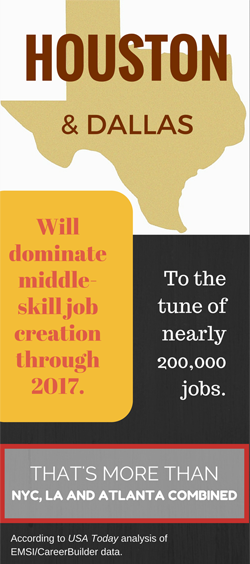Skilled trade vacancies are the hardest to fill jobs in the United States for the sixth consecutive year. The problem hits oil and gas, construction, manufacturing and technology fields hard, which means Texas is the center of the target. The research points to what has been coined the “hollowing out of the middle” – the loss of skilled blue-collar jobs, mostly to the recent recession and moving certain jobs overseas. Now these middle-skill jobs are resurging…with less and less talent to fill the gap.
According to USA Today analysis, Houston is expected to add more than 100,000 middle-skill jobs by 2017. The research shows that some of the most needed workers for oil and gas right now are not only petroleum workers but electricians, pipefitters, carpenters and others who build the necessary infrastructure. What’s more, Chevron and competitor ExxonMobil Chemical are both building giant plants that will triple the output of plastics from Houston alone.Dallas joins Houston in leading all other U.S. metro areas in adding middle-skill jobs through 2017. Several other Texas metros —McAllen, Austin, Killeen and San Antonio — are also among the top metro areas expecting the fastest growth. But they need middle-skill talent to do so.
“This country is facing a shortage of that kind of talent,” Peter Cella, CEO of Chevron Phillips Chemical, told USA Today.
Adding to the talent gaps in all of these major industries—including construction and manufacturing—is the fact that Baby Boomers are leaving skilled jobs at an alarming rate. Nearly one out of every five construction workers is 55 years of age or older. That means there is a minimum of 1.1 million construction workers who are likely to retire within the next 10 years. The talent gap is widening by the retirement of manufacturing workers as well. By 2020, there is predicted to be a shortfall of about 875,000 machinists, welders, industrial-machinery operators and other skilled manufacturing professionals in the U.S. alone.

Perhaps most disturbing is that while about half of U.S. employers acknowledge that talent shortages have a medium to high negative impact on their business, only one-fifth have pursued strategies to overcome it.
What can you do, as an employer, when you know that a talent gap is careening your way? First, job recruiters can help by refining your traditional job candidate searches. For instance, are your current job requirements too restrictive?
“Many great candidates lack the degrees and certifications that some employers require,” says Jim Gilliam, founding partner and chairman of The HT Group. “If you’re willing to loosen the reins in some key areas, you may find the perfect fit, who happens to be highly trainable.”
Second, skills training is more essential than ever. Job placement agencies can help with that, too, by identifying the skills that are critical and helping to incorporate skills training into the onboarding process.
Have you noticed a shift in your own workforce? Is a tsunami gap in skills heading your way? If so, how are you preparing?
Main Image Copyright: ndoeljindoel / 123RF Stock Photo
Infographic Copyright: The HT Group



